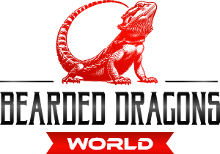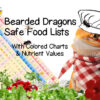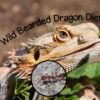Deciding on the best age to buy a bearded dragon, whether an adult or a baby, is an important factor for beginners in reptile ownership. The choice between a baby bearded dragon and an adult bearded dragon comes with distinct care requirements, behavioral expectations, and bonding opportunities.

Jump To…
Key Takeaways
- Choosing an adult or baby bearded dragon impacts the care required and the owner’s experience level.
- Baby bearded dragons cannot be housed with adults due to risk of harm and stress.
- Best age to acquire a young bearded dragon is between 3-6 months of age.
- The best age for you depends on time, experience, and budget.
- Each dragon age offers unique rewards and challenges.
- Proper understanding of a bearded dragon’s needs is essential for creating a suitable habitat and diet plan.
Best Age to Buy a Bearded Dragon for Beginners: Adult or Baby?
The age to get a bearded dragon largely depends on your experience, time availability, desire for bonding, and budget for vet support.
Understanding the age to get a bearded dragon can simplify the decision for first-time pet owners by highlighting the key differences and requirements at each age. Here’s a straightforward guide to help you navigate through the choices and decisions.
Choosing the Right Age for Beginners: Adult Bearded Dragons
Adult bearded dragons are typically recommended for new owners.
- Recommended For: New owners, those with less time for intensive care.
- Temperament: Established and known; more predictable behavior.
- Feeding Schedule: Less frequent, typically once a day or every couple of days.
- Care Level: Generally lower; adults are less demanding in terms of daily care.
- Considerations:
- May have pre-existing health issues or set behaviors from previous care.
- Lower risk of stress from environmental changes due to their resilience.
Juvenile Bearded Dragon: A Transitional Age to Get a Bearded Dragon
A good time to acquire a young bearded dragon is between 3 to 6 months (Raiti, 2012):
- Recommended For: New owners, especially if the age to get a bearded dragon aligns with less intensive care needs.
- Feeding Schedule: 2-3 times a day with a diet that’s transitioning from protein-heavy to include more vegetables.
- Care Level: Moderate; juveniles are less fragile than babies but still require attentive care for their growth and health.
- Considerations:
- Still in a rapid growth phase but less sensitive than babies, making this an intriguing age to get a bearded dragon.
- Ideal for owners wanting to experience some of the developmental stages without the high demands of baby care.
- Housing with other bearded dragons can create stress and changes to time to develop.
Baby Bearded Dragon: Starting at the Earliest Age to Get a Bearded Dragon
A baby bearded dragon is time consuming and a diffcult age for newcomers to start at:
- Recommended For: Owners looking to bond deeply and influence their pet’s development from a young age and have time in the day to dedicate to care.
- Feeding Schedule: More frequent, typically 3 to 5 times a day with a protein-rich diet for growth.
- Care Level: Higher; requires careful monitoring of diet, temperature, and environment.
- Considerations:
- Higher access to heating than an adult due to size difference.
- Careful handling.
- Should not be housed with adult dragons.
Updated Comparison Table:
| Aspect | Adult Bearded Dragon | Juvenile Bearded Dragon | Baby Bearded Dragon |
|---|---|---|---|
| Feeding | Once a day/every few days | 2-3 times a day | 3-5 times a day |
| Temperament | Known and more stable | Forming but adaptable | Opportunity to shape |
| Care Level | Lower | Moderate | High |
| Housing | Solo or with similar sizes. Never 2 males. | Solo to avoid adult aggression | Solo to avoid adult aggression |
| Health Concerns | Possible pre-existing | Growing phase needs monitoring | More sensitive to care mistakes |
What’s The Difference Between Caring For A Baby Vs. Adult Bearded Dragon?
When contemplating the age to get a bearded dragon, consider the pros and cons of starting with a baby versus an adult. While babies can be more labor-intensive and sensitive to environmental and dietary missteps, they allow for a more personalized upbringing.
Adult bearded dragons, although potentially coming with their own set of previous health or behavioral issues, provide a more straightforward care experience ideal for beginners.
The care for baby bearded dragons is more complex, requiring vigilant attention to their dietary needs, which are heavily protein-based to fuel their rapid growth, and their habitat, which must offer a meticulous temperature gradient.
There is less room for errors on ensuring the can metabolise calcium while they are growing. Future health issues can easily be created during this time.
Choosing the Right Age to Get a Bearded Dragon
Selecting the right age to get a bearded dragon impacts care requirements and the bonding experience. Tailoring your choice to your lifestyle and commitment level will make a significant difference to the future of both of you.
The difference between a baby and an adult #beardeddragon is amazing! Bearded dragons originated in the deserts of Australia. They weren’t introduced into the United States until the 1990s, but have since become popular as pets. They are charismatic, intelligent, and very friendly! They have very specific habitat and nutritional requirements which, if not maintained, can lead to medical issues such as mouth rot, upper respiratory infections as well as metabolic bone disease. If you are questioning whether or not your beardies habitat is up-to-snuff shoot us an email and we’ll send you our care sheet! #veterinarymedicine #beardeddragon #beardiesofinstagram #reptiles #exoticvet
Posted by Essex Veterinary Center on Tuesday, March 5, 2019
Requirements According to the Age to Get a Bearded Dragon
Before introducing a bearded dragon to its new home, it is crucial to have the habitat fully assembled and regulated. The needs of baby dragons differ slightly from adults due to their size and growth rate. This can be address by creating the perfect environment for a bearded dragon but adding accessories that allow higher access to heat and UVB than an adult may require.
How Big Should a Baby Bearded Dragon’s Tank Be?
Considering the age to get a bearded dragon is important, as it dictates the enclosure size needed for them to thrive. It is often recommended to keep hatchlings in a 20-gallon tank. Sometimes it is even said that baby bearded dragons are scared in large environments. Baby bearded dragons are naturally born into the wild and have no such natural restrictions. A small tank cannot provide a proper thermal gradient and purchasing a small cage to start with simply adds to the long term costs when it needs to be replaced. Create a much larger environment that baby bearded dragons can grow into.
Essential Bearded Dragon Heating and Lighting
Bearded dragons are ectotherms and rely on external heat sources to regulate their body temperature. With the right temperatures provided and the accessories to access prime basking spots, the bearded dragons of all ages are capable of picking their own suitable basking spot. Both baby and adult dragons need 10-12 hours of UVB lighting daily to synthesize vitamin D3, which is vital for calcium absorption and overall health.
Safe Substrates and Habitats
Choosing the right substrate is a part of responsible care and safety and well-being of your bearded dragon, and it varies depending on the age to get a bearded dragon. For both adults and babies tiles or paper towels are recommended to avoid accidental ingestion. Equipping the tank with accessories such as hiding spots, climbing branches, and basking platforms is essential to promote natural behavior, irrespective of the age to get a bearded dragon. A clean and sanitized environment is vital for both baby and adult bearded dragons.
Diet in a Nutshell from Baby to Adult
When considering the diet and nutrition of bearded dragons, it’s important to understand the distinct needs between babies and adults. Baby bearded dragons require a diet higher in protein to support their rapid growth. They should consume a diet of approximately 80% insects and 20% vegetables.
| Age Group | Insect to Vegetable Ratio | Frequency of Feeding |
|---|---|---|
| Baby | 80% Insects / 20% Vegetables | 3-5 times daily |
| Adult | 20% Insects / 80% Vegetables | Once daily |
Adult bearded dragons, conversely, consume more vegetables than babies, with a shift towards a 20% insect and 80% vegetable ratio. Adults should be fed once daily, while babies require multiple feedings.
The insect portion for babies can include crickets and dubia roaches, which are rich in nutrients. For all ages insects are dusted with calcium powder to support proper growth, health and prevent diseases like metabolic bone disease. For adults, the vegetable portion should be a variety of leafy greens like collard and mustard greens.
Careful attention to feeding size is also necessary. Babies must eat smaller-sized food to prevent choking, while adults can handle larger pieces. Never feed insects that are larger than the space between the dragon’s eyes.
Here’s a brief list of suggested foods for baby bearded dragons:
- Small crickets
- Tiny dubia roaches
- Finely chopped vegetables
Can you put Baby Bearded Dragons with Adults?
You cannot put baby bearded dragons with adults. Bearded dragons do not rear their young, they lay their eggs and leave them. Young bearded dragons will likely end up being viewed as a snack. The risk of aggression or stress from the larger dragons, is too high.
Conclusion: Choosing the Best Ageto get a Bearded Dragon
Understanding the unique needs and considerations for bearded dragons at different life stages is part of providing the best care for your reptilian companion. The commitment to their health and care is a journey that evolves as they grow from a curious baby to a mature adult. By staying informed and attentive to these needs, you’ll nuture a thriving environment for your bearded dragon and forge a deep, rewarding bond that enhances your fun.
FAQs
Can a baby bearded dragon live with an adult?
No, it’s not safe to house baby bearded dragons with adults due to the risk of injury or aggression from the adult.
How does bearded dragon care differ between babies and adults?
Baby bearded dragons need more frequent feedings, daily monitoring, and focus on providing optimal care while they are growing. Adult dragons have less intensive feeding schedules and can adapt more easily to their environment, but may have established behaviors from their past.
At what age does a bearded dragon become an adult?
Bearded dragons typically become adults at around 18 months old.
What is the recommended age to get a bearded dragon for first-time owner?
For first-time owners, it’s recommended to get a bearded dragon that is at least 6 months old, as they are past the fragile early stages yet still young enough to adapt well to new environments.
References
- Raiti, P. (2012). Husbandry, Diseases, and Veterinary Care of the Bearded Dragon (Pogona vitticeps). Journal of Herpetological Medicine and Surgery, 22(3-4), 117–131. https://doi.org/10.5818/1529-9651-22.3.117





